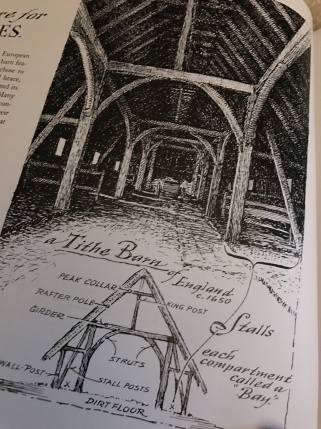Over the past few months, I have been researching barns. The process of preserving the barns at Evergreen Bend has me digging around online and looking for any information about old barns that I can find. At one point I found this amazing quote in a blog about barn restoration. “In his book, An Age of Barnes, Eric Sloane states that “The beauty of wood in the state of pleasing decay is one of Nature’s special masterpieces.” What a great phrase, “pleasing decay”! I am still pondering this phrase, turning it over and over in my mind. It is such a mixture of life and death that I can’t seem to let it go.

On another note, I was so fascinated by this quote that I purchased the book An Age of Barns. Eric Sloane wrote this book in 1967. However, if you didn’t check the copyright date you may believe you uncovered an old sketchbook of barn drawings, cupolas, foundations and chore houses.  It is full of history and art. Even though today’s trend is to decorate with old barn wood, I have found very few “how to” books and articles about early barns and the process of restoring them. I am comforted though, as Eric in his own research was surprised to find “next to nothing” about the history or construction of barns.
It is full of history and art. Even though today’s trend is to decorate with old barn wood, I have found very few “how to” books and articles about early barns and the process of restoring them. I am comforted though, as Eric in his own research was surprised to find “next to nothing” about the history or construction of barns.
He surmises that building knowledge was verbally passed on from one generation to another. The book “Building Barns for Dummies” hadn’t been written and http://www.barnbuilding.com was offline. Early American pioneers brought their knowledge of how to construct a barn from their homelands; making it simply remarkable that old barns across America have so much in common.
So, what then is a barn and why do they exist today? 
Well, Mr. Sloane also explained after 500 AD, the word barn originally meant “a place for barley.” It combined the old English word bere (barley) and aern (place). Can you slur that together? Barley–aern…bar–aern…bearn…barn.
One of the pictures sketched in the book was of an old European tithe barn. During the Middle Ages, many of the old tithe barns were used for storing up the contributions for the church. We also see similar practices in the early church. The historical book of Second Chronicles explains this practice and the customs that the early church held fast to. In chapter 31 verses 4-5, “He (God) ordered the people living in Jerusalem to give the portion due the priests and Levites so they could devote themselves to the Law of the Lord. As soon as the order went out, the Israelites generously gave the firstfruits of their grain, new wine, olive oil and honey and all that the fields produced. They brought a great amount, a tithe of everything.” 
And the “bearn” held all that tithe! The barns held barley and all that the fields produced!
This practice of holding grain dates back even further than 500 AD. In fact, as far back as 3,000 BC, we know that the Ancient Egyptians made a practice of preserving grain in years of plenty against years of famine. The climate of Egypt, being very dry, allowed grain to be stored in pits for a long time.
In Genesis 41 verse 49 we read that during the seven years of plenty, “Joseph stored up huge quantities of grain, like the sand of the sea; it was so much that he stopped keeping records because it was beyond measure.” However, when the seven years ended and the famine began, verse 56 tells us that when “… the famine had spread over the whole country, Joseph opened all the storehouses and sold grain to the Egyptians.”
The pits, the storehouses, a place for barley or grain, a place for storing up. All are barns.
The barns are so cool, such history and so much to learn about the why’s and how’s of their creation. However, I don’t see us storing up barley or even hay in Evergreen Bend Farm’s barns. They may have at one time, but I see us storing up other things: treasured time with our loved ones, our community, and our friends. Jesus is tugging on my heart as I hear him whisper,
“Do not store up for yourselves treasures on earth, where moths and vermin destroy, and where thieves break in and steal. But store up for yourselves treasures in heaven… For where your treasure is, there your heart will be also.” Matthew 6: 19-21
You are our treasures.
♥ Meghan

I learned somethig new from you, “Baern!” Our 100-year-old barn is used to cover the neighbor’s combine, store hay and discarded snakeskins. I don’t go in there! Lol
LikeLike